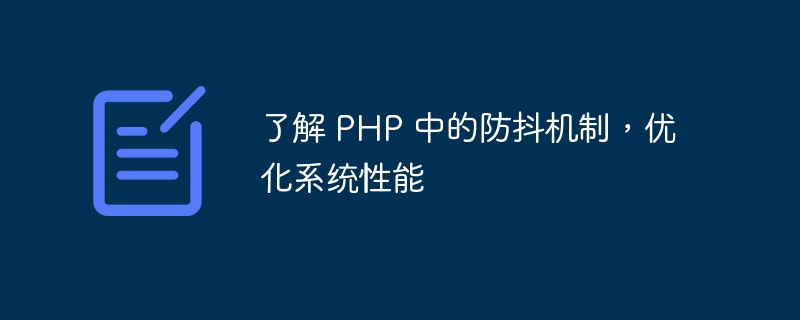

To understand the anti-shake mechanism in PHP and optimize system performance, specific code examples are needed
When developing web applications, we often encounter problems that users frequently operate situations, especially when triggering certain sensitive operations. For example, a user clicking a button multiple times quickly may cause the system to perform the same action multiple times, wasting server resources and user waiting time. In order to solve this problem, PHP provides an anti-shake mechanism, which can effectively optimize system performance.
Anti-shake means that if multiple consecutive identical events are triggered within a specified time interval, only the last event will be executed. Through the anti-shake mechanism, we can avoid repeated operations and improve the system's response speed and user experience.
In PHP development, we can use a timer and an identification variable to implement the anti-shake function. The specific code example is as follows:
<?php
function debounce($callback, $wait = 500) {
$timerId = null;
return function (...$args) use ($callback, &$timerId, $wait) {
if ($timerId !== null) {
clearTimeout($timerId);
}
$timerId = setTimeout(function () use ($callback, &$timerId, $args) {
$callback(...$args);
$timerId = null;
}, $wait);
};
}
// 示例用法
$debouncedFn = debounce(function ($data) {
// 处理业务逻辑
echo "处理数据:" . $data;
}, 1000);
// 模拟用户快速点击操作
$debouncedFn('数据1');
$debouncedFn('数据2');
$debouncedFn('数据3');
$debouncedFn('数据4');
?>In the above code, we define a debounce function, which receives a callback function and a waiting time parameter. Inside the function, we use a $timerId variable to save the timer's identity. When the anti-shake function is called, if the timer exists, the previous timer is cleared; then a new timer is reset, and a closure function is used to execute the callback function after the specified time. When the timer executes the callback function, the timer ID will be cleared.
In the example usage of the code, we created a debounce function $debouncedFn, which triggered multiple function calls in a row during the simulated user's quick click operation. Since the debounce is set to 1000 milliseconds, only the last call will trigger the callback function, and the rest of the calls will be ignored.
By using PHP's anti-shake mechanism, we can flexibly control the trigger frequency of certain sensitive operations to avoid unnecessary waste of resources. However, we need to set the anti-shake waiting time reasonably according to actual needs to ensure a balance between user experience and system performance.
In summary, understanding the anti-shake mechanism in PHP and applying it in practice can optimize system performance, make user operations smoother, and improve user experience.
The above is the detailed content of Understand the anti-shake mechanism in PHP and optimize system performance. For more information, please follow other related articles on the PHP Chinese website!